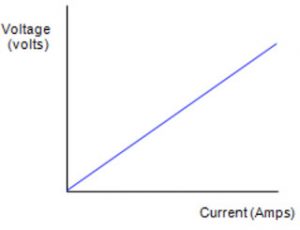Question 1 State ohm’s law?
Question 2 What is the resistance of an electric arc lamp, if the lamp uses 20 A when connected to a 220 Volt line?
Question 3 Define resistance of a conductor. What is its SI unit?
Question 4 Write the formula which relates electric current, time and electric current?
Question 5 What kind of plot would you expect when current is plotted against potential difference?
Question 6 What happens to the resistance as the conductor is made thinner?
Question 7 What is the SI unit of resistance?
Question 8 What is the use of rheostat?
Question 9 Define the term variable resistance?
Question 10 What is a good conductor?
Question 11 What is a bad conductor?
Question 12 What are insulators?
Ohm’s Law
George Simon ohm(in 1826)studied relationship between I and V across the ends of conductor.
Ohm’s Law states that electric current flowing in a conductor is directly proportional to potential difference across the ends of the conductor, provided temperature and other physical conditions remains constant.
V=IR
R=Resistance of conductor
Resistance of a conductor is the property of conductor to oppose the flow of charge through it.
R = V/I
Unit of resistance is ohm
1 ohm = 1 Volt / 1 Ampere
Resistance of a conductor is said to be 1 ohm if a potential difference of 1 volts across the ends of conductor makes a current of 1 ampere to flow through it.
Slope = I / V
Slope of graph V and I=Resistance of a conductor
V=IR
I= V/R
If R is halved then I is doubled.
If R is doubled then I is halved.
In an electric circuit, sometimes current has to be increase or decrease. A component used in an electric circuit to change the current without changing the potential difference across the circuit is called variable resistance.
Rheostat is a device used in electric circuit to change the resistance and hence current in circuit.
A conductor or material which offers low resistance to the flow of electrons or electric current in an electric circuit is called as good conductor.
A conductor or material which offers higher resistance to the flow of electrons or electric current in an electric circuit is called as bad conductor.
A material which offers very high resistance to the flow of electrons or electric current in an electric circuit is called as insulator.

Nyc notes.
It is helpful for me.
Perfect derived the notes
Thank you.It helped me alot
Thank You. It helped to make my notes better….
Thanks for your kindness,I learnt a lot now
Nice!!
Superb notes!! Thanks a lot. Exceptionally clearly explained. Crisp and concise notes!! GOOD JOB!
Clear and Nice, thank you 🙂